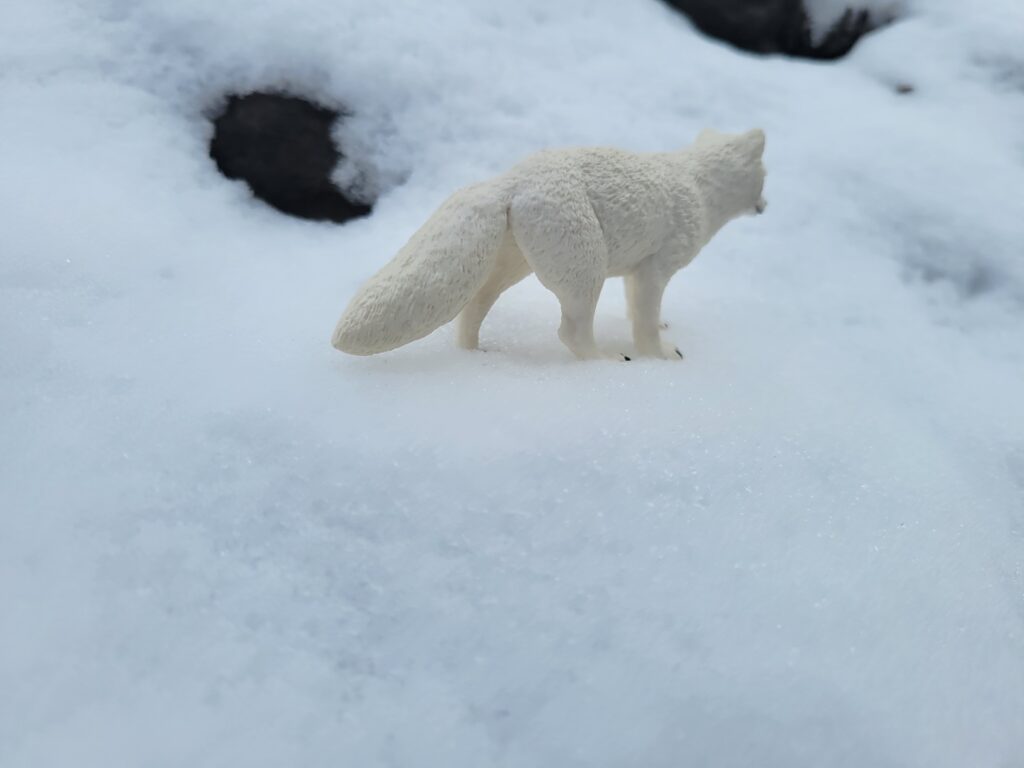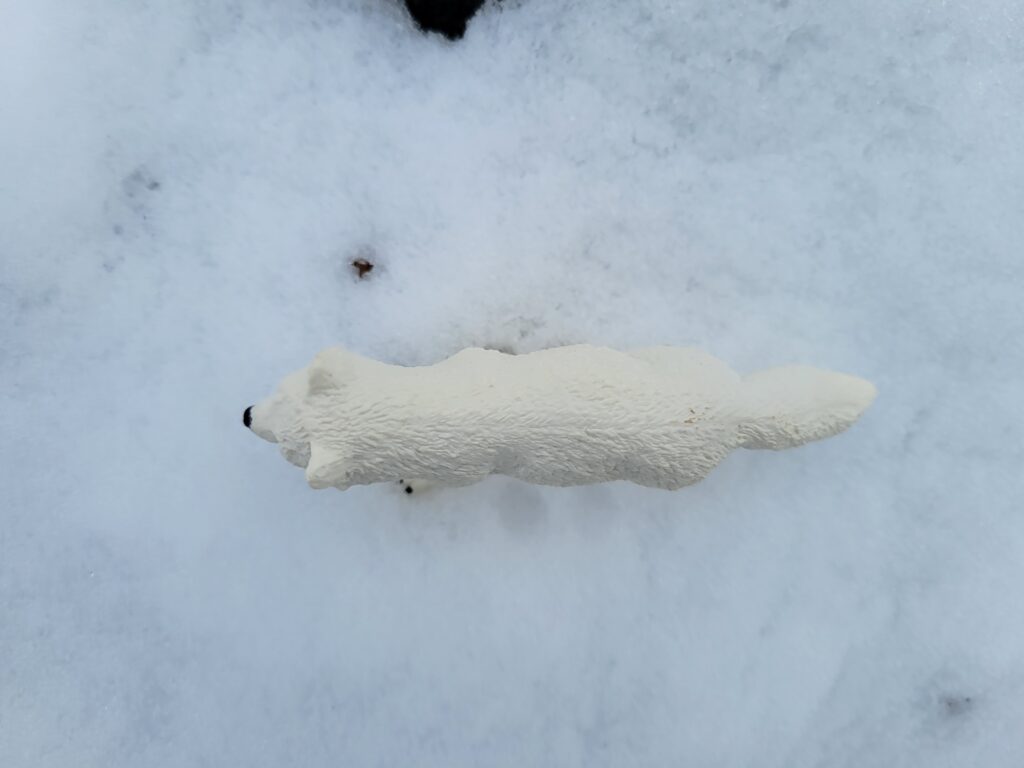
Off we go back to the Arctic to explore another extreme climate inhabitant… the Safari Ltd. Arctic fox for 2023! Released under the item number of #100731, it presents a very special Arctic animal. This will also be the first post for this species on the blog! Unlike the Arctic wolf discussed in another recently released blog post, this animal is a unique species to its mainland cousin. And just as they do in the wild when hunting small vermin in the snow… let’s dive right into it!

Most people are familiar with these little guys but here is a recap of information and perhaps some new items of interest. Generally, they live in the Arctic tundra and endure freezing temperatures. The iconic white winter coat is designed for superior insulation; it even gives them a more rounded shape to reduce heat loss! In the summertime, they shed this thick white coat and become variable shades of dark gray or muddy brown to help them blend in to the summer time landscape. There are two coat types however; traditional white and lesser known “blue”. The blue morph fox stays a charcoal-brown/gray color year-round regardless of having a winter or summer coat. It is also much rarer to see, though it is a dominant allelle over that which codes for white. Arctic foxes have very small rounded ears, short muzzles, and shorter legs than their more familiar red fox cousins, and they are quite smaller than them too. Their winter coat keeps them warm in temperatures of cold exceeding that of -70 degrees Celsius/-94 degrees Fahrenheit (this is the temperature where they only begin to shiver!). Their foot pads are even coated with fur! These guys are monogamous and come together year after year to reproduce and raise a litter of kits. They often feed on lemmings, but also feed on arctic birds and their eggs, seal pups, voles, fish, and invertebrates. Their diet can’t be too picky; they have to take whatever opportunity presents itself as. Because they are so small, they do have a lot of predators also- golden eagles, Arctic wolves, polar bears, wolverines, grizzlies, and even the larger red fox.

Now, what has this got to do with winter or New Year’s celebrations? Besides the obvious that is… The connection would be two fold in this instance. For one, in Finnish mythology (and some other scattered Nordic cultural stories), the Arctic fox is responsible for a phenomena that still entrances human beings to this day. Legends tell that the “fire foxes”, that would be the Arctic foxes of the North, are the bringer of the Aurora Borealis. The two most common tales describe how when the foxes would run through the sky and their bushy tails brushed the mountain tops, sparks would fly up and ignite the night sky with stunning colors that danced across the darkness. The other story tells that just as the foxes ran through the winter snow and stirred up snowflakes that flew up skyward, these would catch what little light there was from the stars and moon to create this montage of colors and movement that are known as the Northern lights. Goes to show that the foxes of the northern frozen wastes and the phenomena of the sky full of lights have entranced people for centuries.

The other tale, while perhaps not explained by Arctic foxes directly, regards the Inari god and his fox companions from Japan. The general idea of this is that Inari, one of the more popular and worshipped kami (gods) even to this day, is a god of prosperity and hope for things to come. He is often linked to the trickster foxes of Japan, especially the yokai kitsune (a fox-like shapeshifting creature that is often depicted as snowy white and has up to nine tails depending on its age and power. Possibly even a small fire ball floating nearby…). These foxes can be benevolent messengers or often perform deviant acts of tricks on people most of the year; they are renowned for their cleverness and joy for tom-foolery. However, on this one night every year, December 31st, all this trickery and deviant behavior is forstalled. The people of Japan and the kitsune would gather on this night to pay homage to their kami Inari, asking for prosperity for the coming year. The kitsune shapeshift into humans and don beautiful kimonos, and all that had gathered (faux humans and real ones alike) would leave gifts at the sacred tree in Oji (an enoki or Japanese Hackberry tree) of sake, rice treats, and other appeasements. Once midnight strikes, the gatherers light lanterns and begin the Kitsune no Gyoretsu or the Parade of the Foxes to welcome in the new year and visit nearby shrines (to start the new year on the right foot so to speak). Today this is still done, and while the original enoki that was worshipped has died, the parade still gathers at a shrine made in its honor and walks down to the Oji Inara Jinji Shrine to worship Inari; complete with faces painted like kitsune, colorful kimonos, bright paper lanterns, and offerings for the kami under their arms. There is a beautiful illustration of this story made by Master Hiroshige Ukiyo-e that depicts these foxes that are the color of moonlight gathering under the sacred enoki in the lavender and navy darkness of a New Year’s Eve.

Moving on to the model at hand, I think Safari improved immensely upon previous renditions of this species. The new figure is not a “blue-white”, instead it takes advantage of a rarely used type of white which more accurately represents white fur to the human eye; this model is a “yellow-white” shade, also known as cream or off-white. The body here shows much better proportions for this species than previous Safari versions and also presents a winter-coat version- my dream of a summer-coat Arctic fox lives on. This figure has the true features of an Arctic fox; blunt rounded ears, a shorter muzzle, more triangular eyes, and the “poof” of a proper winter coat. The texture of such is really well done and is pleasing when in hand as well as to the eye. And the figure even goes so far as to get one important detail right… fur covering the feet pads! The nails including the dewclaw are painted as well. Safari was even considerate of collectors for this figure and printed the number on the bottom of a foot instead of on a visible portion for the figure. All in all, I think it was really well done and is fathoms above and beyond its predecessor!

I hope you consider adding this model to your collection simply due to its masterful sculpting. Who knows? Perhaps the kami or the Northern lights will smile down upon you!

Disclaimer: links to Ebay and Amazon on the AnimalToyBlog are affiliate links, so we make a small commission if you use them. Thanks for supporting us!




A marked improvement over earlier versions by Safari for sure. If I didn’t have this species I’d consider it, but I think I’ll stick with Papo.
I love your photos in the Snow.